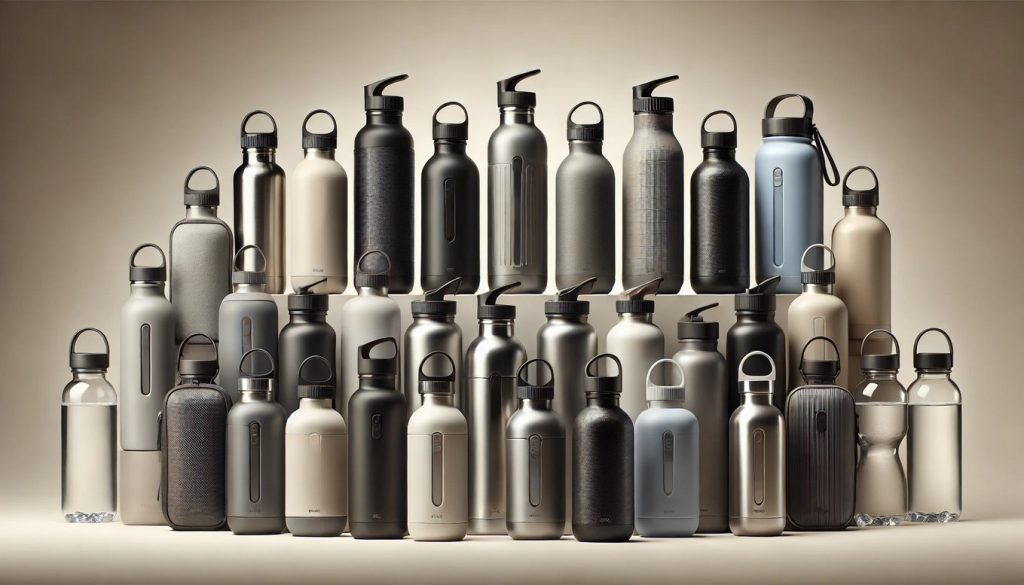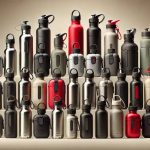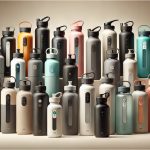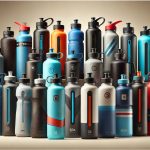Compact hydration bottles are an essential piece of gear for outdoor enthusiasts, athletes, travelers, and anyone who needs to stay hydrated while on the go. Whether you’re trekking through the mountains, cycling across town, or navigating a busy workday, these small yet efficient bottles allow you to carry water conveniently without adding unnecessary bulk to your bag or gear.
What Are Compact Hydration Bottles?
Compact hydration bottles are smaller, lightweight bottles designed for carrying liquids, usually water, in a convenient and portable format. Their compact size makes them perfect for on-the-go hydration, allowing you to easily carry them in a backpack, gym bag, or even a pocket. Despite their small size, these bottles are designed to hold a sufficient amount of liquid to keep you hydrated during short to moderate activities without taking up too much space.
Features of Compact Hydration Bottles
Compact hydration bottles are often designed with features that prioritize portability, convenience, and ease of use, including:
- Lightweight Design: These bottles are made from lightweight materials such as plastic, aluminum, or collapsible materials to ensure that they are easy to carry.
- Leak-Proof: Many compact bottles are designed with leak-proof lids or caps to prevent spills when not in use.
- Compact Shape: They are generally smaller in size, ranging from 250 ml to 750 ml, making them easy to fit into side pockets of backpacks or bike racks.
- Convenient Drinking Mechanism: Features such as flip-top lids, straws, or bite valves make drinking easier and more efficient during activities.
Types of Compact Hydration Bottles
There are several different types of compact hydration bottles, each designed to serve particular needs or preferences. Whether you are looking for a bottle for daily use, outdoor adventures, or sports activities, there’s a type of compact hydration bottle that will work best for you.
Plastic Hydration Bottles
Plastic hydration bottles are one of the most common types of compact bottles available. They are lightweight, affordable, and available in a wide range of sizes, colors, and designs.
Features of Plastic Bottles
- Durability: High-quality plastic bottles are durable and resistant to impacts, making them suitable for everyday use and outdoor activities.
- BPA-Free: Many plastic bottles are now made from BPA-free plastic, which helps ensure that harmful chemicals do not leach into the water.
- Variety of Designs: Plastic bottles come in various shapes, sizes, and designs, allowing users to choose a bottle that fits their specific needs.
Common Uses of Plastic Hydration Bottles
- Daily Use: Plastic bottles are perfect for carrying water to work, school, or the gym.
- Sports and Exercise: These bottles are often used by athletes due to their lightweight nature and easy-to-use lids.
- Outdoor Activities: Plastic hydration bottles are great for hiking, running, or cycling because they are portable and practical.
Stainless Steel Hydration Bottles
Stainless steel hydration bottles are another popular option. Known for their durability and insulating properties, stainless steel bottles are perfect for keeping drinks cold or hot for extended periods.
Features of Stainless Steel Bottles
- Insulation: Many stainless steel bottles are double-walled and vacuum-insulated, helping to maintain the temperature of beverages for hours. Cold drinks can stay cool, and hot beverages can stay warm.
- Durability: Stainless steel bottles are extremely durable, resistant to corrosion, and able to withstand the rigors of outdoor use.
- BPA-Free: Like plastic bottles, stainless steel bottles are free of BPA and harmful chemicals.
- Eco-Friendly: Stainless steel is 100% recyclable, making it a more sustainable option compared to single-use plastic bottles.
Common Uses of Stainless Steel Hydration Bottles
- Outdoor Adventures: These bottles are popular for hiking, camping, and other outdoor activities, where you need both portability and temperature retention.
- Travel: Stainless steel bottles are ideal for travelers who want to keep drinks at a desired temperature during long journeys.
- Commuting: Stainless steel bottles are often used by people on their daily commute, as they keep beverages at an ideal temperature for hours.
Collapsible Hydration Bottles
Collapsible hydration bottles are designed to save space by folding down when not in use. Made from soft materials such as silicone, these bottles can collapse to a fraction of their size, making them ideal for travel or outdoor activities where space is limited.
Features of Collapsible Bottles
- Space-Saving: The primary advantage of collapsible bottles is their ability to fold down to a compact size when they are empty, making them perfect for packing in small spaces.
- Lightweight: Collapsible bottles are typically made from flexible, lightweight materials, making them easy to carry and store.
- Durable: These bottles are made from tough materials like silicone or flexible plastic, so they can withstand repeated folding and bending without breaking.
Common Uses of Collapsible Hydration Bottles
- Traveling: Collapsible bottles are perfect for travelers who need a bottle that takes up minimal space when empty.
- Outdoor Activities: These bottles are excellent for hiking or camping trips where pack size is important.
- Emergency Preparedness: Collapsible bottles are often included in emergency kits because they provide an efficient water storage option without taking up space.
Glass Hydration Bottles
Glass hydration bottles are an eco-friendly alternative to plastic and stainless steel bottles. They are chemical-free and offer a pure drinking experience, though they are less common as compact options due to their fragility.
Features of Glass Bottles
- Pure Taste: Glass does not affect the taste of water, providing a clean and fresh drinking experience.
- Non-Toxic: Glass is naturally free from harmful chemicals such as BPA, making it a safe choice for hydration.
- Aesthetic: Glass bottles often have a sleek, elegant look, appealing to those who prioritize both functionality and design.
- Reusable: Glass bottles are durable and can be reused indefinitely, making them an eco-friendly choice.
Common Uses of Glass Hydration Bottles
- Office Use: Glass bottles are often used at work or school due to their elegant design and non-toxic properties.
- Health-Conscious Individuals: Many people who are concerned with drinking from chemical-free containers prefer glass bottles.
- Eco-Conscious Consumers: Glass bottles are a great choice for individuals seeking to reduce their environmental impact and avoid plastic waste.
Factors to Consider When Choosing a Compact Hydration Bottle
There are several important factors to consider when selecting the best compact hydration bottle for your needs. These factors will help you determine the bottle’s functionality, ease of use, and overall suitability for your lifestyle.
Material
The material of the hydration bottle plays a significant role in its durability, weight, and temperature control capabilities. Consider the material based on your priorities such as insulation, taste, and eco-friendliness. Stainless steel and plastic are the most common materials, with glass and silicone offering eco-conscious alternatives.
- Plastic: Lightweight and affordable, but can retain odors and may not keep drinks cold or hot for long.
- Stainless Steel: Offers excellent insulation, durability, and temperature retention, making it ideal for outdoor activities and long periods of use.
- Glass: Provides a pure taste with no chemical leaching, but it is heavier and more fragile than plastic or stainless steel.
- Collapsible Materials: Ideal for reducing bulk in your pack, though these bottles generally don’t offer temperature control.
Capacity
Compact hydration bottles typically have smaller capacities compared to regular water bottles. The most common sizes range from 250 ml to 750 ml, but some bottles can hold as much as 1 liter. When choosing the right size, consider your hydration needs and the length of time you will be away from a water source.
- Small Bottles (250 ml – 500 ml): Perfect for short outings, gym sessions, or casual use when you don’t need to carry much water.
- Medium Bottles (500 ml – 750 ml): Ideal for moderate physical activity or longer hikes where more hydration is required.
- Large Bottles (750 ml – 1 liter): Suitable for longer excursions, like full-day hikes or multi-hour commutes.
Portability
Portability is one of the most important features of a compact hydration bottle. Since these bottles are meant to be carried on the go, they need to be lightweight and easy to transport. Look for features like:
- Carry Loops or Straps: Many compact bottles come with loops or carabiner hooks that make it easy to clip them to your bag.
- Slim Shape: A slim, streamlined design allows the bottle to fit in tight spaces, such as the side pocket of a backpack.
- Ergonomic Shape: Some bottles have an ergonomic design for easy gripping, making it more comfortable to hold during physical activity.
Insulation and Temperature Control
If you need to keep your drinks cold or hot, consider a bottle with insulation. Double-walled or vacuum-insulated bottles are designed to maintain the temperature of your drink for several hours.
- Cold Beverages: Insulated bottles can keep your water cool for hours, which is especially important in hot climates or during exercise.
- Hot Beverages: Some compact hydration bottles can keep beverages hot for up to 12 hours, making them perfect for carrying tea, coffee, or soup.
Ease of Use
The design and ease of use of the bottle are also critical considerations. You want a bottle that is convenient to drink from, especially during physical activities.
- Wide Mouth: A wide mouth makes it easier to fill the bottle with ice cubes or to clean it thoroughly.
- Straw or Bite Valve: These features make drinking more efficient during activities like running or biking, allowing you to hydrate without needing to remove the cap.
- Leak-Proof: Ensure the bottle is leak-proof, especially if you plan to carry it in a backpack or bag.
Durability
Durability is essential, particularly if you plan on using the bottle for outdoor activities or in rugged conditions. Stainless steel and plastic are generally the most durable materials, while glass bottles can break if dropped. Look for bottles with reinforced exteriors or protective sleeves if you’re concerned about durability.
Price
Compact hydration bottles come in a wide range of price points, depending on the material, design, and additional features. While plastic bottles are typically more affordable, high-quality stainless steel or glass options may come with a higher price tag. However, investing in a durable, long-lasting bottle can save money in the long run by reducing the need for single-use plastic bottles.
Style and Design
Finally, the design and style of the bottle may also influence your decision. Many compact hydration bottles come in various colors, patterns, and finishes. Whether you prefer a sleek, minimalist design or something bold and colorful, the bottle you choose should match your personality and preferences.






